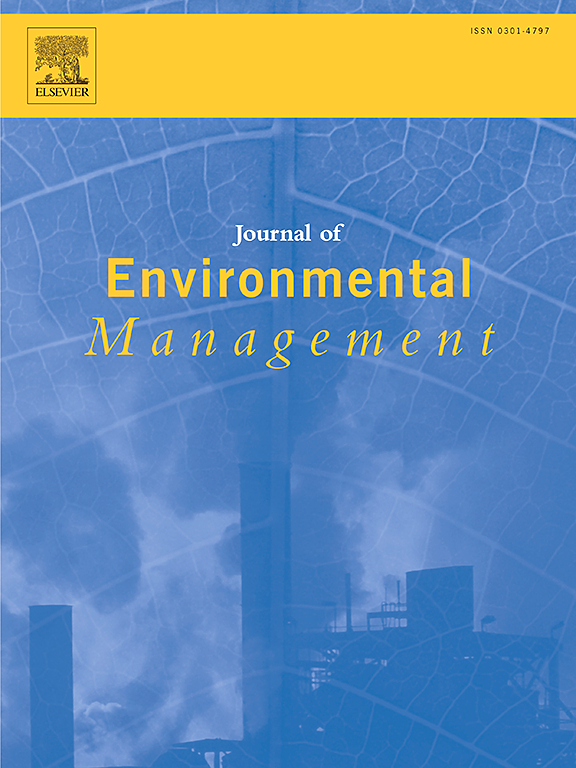退役风力涡轮机叶片特征部件在多种热气氛下的演变:热分解特性和动力学行为
IF 8
2区 环境科学与生态学
Q1 ENVIRONMENTAL SCIENCES
引用次数: 0
摘要
由于缺乏足够的数据和对退役风力涡轮机叶片(RFTBs)热分解动力学的深入了解,严重阻碍了其热回收和升级。本研究探讨了惰性N2气氛、反应空气和CO2气氛下RFTBs的非等温热解,升温速率为10-30 K/min。PET组分(C1)和全RFTBs组分(C3)在N2中有两个热解阶段(Py1和Py2),而玻璃纤维增强聚合物(C2)只有一个热解阶段。由于热滞后,较高的加热速率使热失重率的峰值向上移动。在空气和二氧化碳气氛下,所有原料都发展了一个额外的气化阶段(Gs, >400°C),源于产品在空气中发生部分氧化反应和在二氧化碳中相互作用。这两种途径都通过局部热增强释放热量,加速热解,有效地减少了通过短距离能量再分配的传热限制。C3的表观活化能分别为148.43/181.34 kJ/mol (Py1/Py2, N2)、151.07/151.57/136.62 kJ/mol (Py1/Py2/Gs,空气)和67.76/87.79/78.85 kJ/mol (Py1/Py2/Gs, CO2),表明空气自热热解和CO2气化比传统的N2热解更活跃、节能。模型拟合方法揭示了随机成核和核生长的最佳机制(Py1为n = 4, Py2和Gs为n = 2/3),准确描述了全RFTBs组分的CO2气化,并通过动力学补偿效应分析对其进行了验证。该研究为RFTBs热解过程和反应器的设计、优化和规模化提供了准确和关键的指导。本文章由计算机程序翻译,如有差异,请以英文原文为准。

Evolution of characteristic components from retired wind turbine blades in multiple thermal atmospheres: thermal decomposition characterization and kinetic behavior
The lack of adequate data and in-depth insights into the thermal decomposition kinetics of retired wind turbine blades (RFTBs) critically impede its thermal recycling and upgrade. This study explores the non-isothermal pyrolysis of RFTBs under inert N2 atmosphere and reactive air and CO2 atmospheres at heating rates of 10–30 K/min. The PET component (C1) and full RFTBs component (C3) exhibited two pyrolysis stages (Py1 and Py2) in N2, whereas the glass fiber reinforced polymer (C2) revealed only one pyrolysis stage. Higher heating rates shifted peaks of heat weight loss rate upward due to thermal hysteresis. Under air and CO2 atmospheres, all feedstocks developed an additional gasification stage (Gs, >400 °C), originating from products undergoing partial oxidation reactions in air and interactions in CO2. Both pathways release heat that accelerates pyrolysis through localized thermal enhancement, effectively reducing heat transfer limitations via short-distance energy redistribution. Apparent activation energies for C3 obtained via Model-free fitting method were 148.43/181.34 kJ/mol (Py1/Py2, N2), 151.07/151.57/136.62 kJ/mol (Py1/Py2/Gs, air), and 67.76/87.79/78.85 kJ/mol (Py1/Py2/Gs, CO2), demonstrating that autothermal pyrolysis in air and CO2 gasification are more active and energy-saving than traditional pyrolysis in N2. Model-fitting method revealed optimal mechanisms involving random nucleation and nuclei growth (An, n = 4 for Py1, n = 2/3 for Py2 and Gs), accurately describing CO2 gasification of full RFTBs component, and these were validated through kinetic compensation effect analysis. This study provides accurate and critical guidance for the design, optimization and scale-up of RFTBs pyrolysis procedures and reactors.
求助全文
通过发布文献求助,成功后即可免费获取论文全文。
去求助
来源期刊

Journal of Environmental Management
环境科学-环境科学
CiteScore
13.70
自引率
5.70%
发文量
2477
审稿时长
84 days
期刊介绍:
The Journal of Environmental Management is a journal for the publication of peer reviewed, original research for all aspects of management and the managed use of the environment, both natural and man-made.Critical review articles are also welcome; submission of these is strongly encouraged.
 求助内容:
求助内容: 应助结果提醒方式:
应助结果提醒方式:


